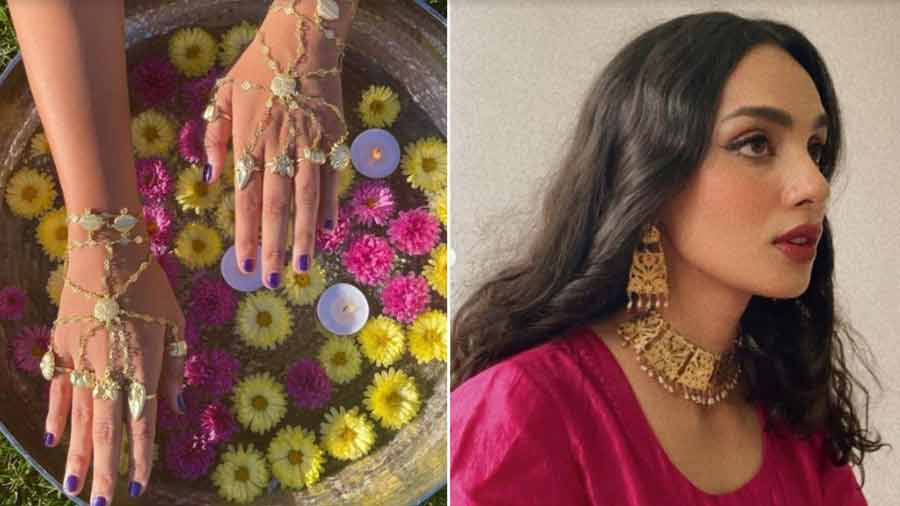When Tyra Banks’ friend walked into Astha Jagwani’s Jaipur studio, she fell in love with a haathphool. “I remember Anusha Dandekar had brought Tyra’s friend to our store. She loved the Mashrabiya golden haathpadma and wanted to take one back for Tyra. A few weeks later Tyra wore it and shared a picture. The haathphool featured Mashrabiya patterns traditionally found in Islamic architecture. For new-age buyers, the focus is now on pieces which stand out and look good on Instagram,” Jagwani tells us.
While celebrities are obviously drawn to ‘exotic’ jewellery, on the homefront, younger shoppers are seeking out old-world pieces for entirely different reasons. Gen-Z is obsessed with jewellery that looks like it was borrowed from their grandmum’s collection, and brands are catering to the modern heirloom trend that also highlights diverse cultural elements.
“My label Kharikajai promotes lost, indigenous Assamese Kattai work and brings back the nostalgic designs of the past which we rarely get to see today, like the beautiful mayur japi and the authentic design of Junberi etc,” says Kharikajai’s Shivani Sharma.
Antique picks like sita haars, bugadis, and traditional mantasa necklaces are being re-imagined for a modern buyer base who want their fashion to tell a story. If you’re looking to style old-world picks this season, here are some great options:
Bugadi
Bugadis are old-school upper ear cuffs that originated in Maharashtra. A traditional Peshwai-style bugadi is typically quite ornate, but Geetanjali Gondhale’s silver jewellery label Moha is all about translating heritage into wearable, everyday jewellery.
Moha’s bugadis are light, dressy and versatile. You’ll spot snug, pierced styles and efficient clip-ons. Moha also offers old school naths and some stunning tribal pieces.
Shop here: https://mohabygeetanjali.com/collections/bugadi
Parandi
Pallavi and Malvika Lalwani’s upcycled label Ziddi is working towards bringing back the dying art of thread craft and their pieces are made by a community of Rajasthani patwa artisans. Their parandis have garnered a lot of attention and are designed as contemporary accessories.
A traditional Punjabi Parandi features blingy, metallic elements. But Ziddi’s parandis are more creative and are designed to be boho chic. They’re colourful and made with cotton wool, thread and cowrie shells, so they can be paired with urban picks.
Shop here: https://www.shopziddi.com/brooches-copy
Started in 2012, Harshita Gautam’s Nomad takes inspiration from rural India. The label’s fabric flower parandis resemble gajras and can be worn around hair buns or even braids.
“The parandi was our first product which we created with excess fabric generated from garment production. Our textile jewellery is highly sustainable since we work with chanderi and mashru silks. The response has been fabulous, everyone likes to put flowers in their hair irrespective of age,” Gautam shares.
Shop here: https://www.diariesofnomad.com
Toe rings
“Toe rings have been around for ages but the designs were all the same, very ‘seen-and-done’. I noticed only the older generation was wearing them. Youngsters weren’t too keen on toe rings. That’s when I realised I can make this category more versatile. I came up with an aesthetic that represents tribal roots and yet feels very contemporary,” says Divya Batra, co-founder and design head of Quirksmith.
Besides horseshoe and dainty floral designs, their text-based toe rings are also worth a try.
Shop here: https://quirksmith.com/collections/toe-rings
Septum Ring
Kritha Makwana’s brand philosophy is to create ornaments that wear the human body and not the other way round. Her label Krithaa just dropped a Nasal series featuring clip-on septum rings in brass that give a sleek do-over to quintessential tribal styling.
These septum rings have strong geometric shapes and despite being over-the-top and eye-catching, they can effortlessly fit into a casual fashion memo.
Shop here: https://krithaa.com/nosepin
Sita haar
“Assamese jewellery has a rich heritage but it has never really found representation in the global fashion industry. I’m Assamese and wanted to uphold the intricate design language found in traditional Assamese jewellery,” Kharikajai’s Shivani Sharma tells us. The bootstrapped Assamese label is re-imagining vintage designs of the east, such as a mantasa and sita haar. Their gold-plated, layered sita haar is a hit in the bridal circuit too.
Afghani Kuchi Headband
Afghan jewellery’s resurgence isn't difficult to explain. The exaggerated, grandiose elements found in Kuchi jewellery seamlessly fit into the boho chic memo because they were originally designed by nomadic gypsies (the Pashtun tribe). Akanksha Chauhan’s Bauble Love offers handcrafted Afghan headbands that capture the vintage, bohemian touch effortlessly but also retain a new-wave element.
Shop here: https://baublelove.in/collections/afghan-hair-pins
